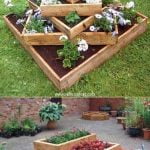Beach gardens are a beautiful way to embrace the coastal lifestyle and bring the tranquility of the beach to your own backyard. Whether you live by the sea or simply want to recreate that serene, breezy atmosphere, there are plenty of creative ideas for designing a stunning beach garden that thrives in a coastal environment.
From choosing the right location to selecting salt-tolerant plants and incorporating water features, this article will explore various aspects of creating a beautiful beach garden that complements the beauty of the sea.
When it comes to beach gardens, there is no shortage of inspiration from nature’s breathtaking coastal landscapes. The combination of sun, sand, and surf provides a unique canvas for creating a lush and inviting outdoor space. Whether you prefer a tropical oasis, Mediterranean retreat, or a contemporary coastal design, there are endless possibilities for capturing the essence of the beach in your garden.
In this article, we’ll delve into key considerations for choosing the right location for your beach garden, explore different types of beach gardens such as coastal, tropical, and Mediterranean styles, and provide creative landscaping ideas for incorporating natural elements like sand, rocks, and driftwood into your design.
Additionally, we’ll discuss how to select beach-friendly plants and flowers that can thrive in salty conditions while also exploring water features and outdoor living spaces that enhance the overall ambiance of your seaside sanctuary.
Choosing the Right Location
When it comes to creating a beach garden, choosing the right location is crucial to the success of your project. Here are some factors to consider before getting started:
- Proximity to the water: Depending on how close you are to the water, the level of salt in the air can vary. If you are right on the beach, you’ll need to choose plants that can tolerate high levels of salt and wind. If you’re further inland, you may have more flexibility with your plant choices.
- Sun exposure: Beach gardens often have ample sunlight, but it’s important to take note of any shaded areas as well. Consider which plants thrive in full sun and which ones prefer partial shade to ensure a harmonious garden layout.
- Soil quality: The soil near beaches is often sandy and lacking in nutrients. Take a look at the soil composition in your chosen location and consider amending it with organic matter or fertilizers if needed.
Once you’ve taken these factors into account, you can move on to selecting the specific types of beach garden that will thrive in your chosen location. Whether it’s a coastal garden, tropical oasis, or Mediterranean-inspired retreat, there are endless opportunities for creative expression when it comes to crafting a stunning beach garden.
Finally, don’t forget about incorporating outdoor living spaces into your beach garden design. From cozy lounging areas with comfortable seating options to inviting al fresco dining spaces with ocean views, there are countless ways to enhance your beach garden experience and make the most of your beautiful surroundings.
Types of Beach Gardens
When it comes to creating an exquisite beach garden, one of the most important decisions a gardener must make is choosing the right type of garden style. Coastal, tropical, and Mediterranean beach gardens each offer their own unique charm and beauty, and selecting the right style for your space can help you achieve the perfect seaside oasis.
Coastal gardens are ideal for those looking to create a natural and windswept look that complements the surrounding environment. Incorporating native plants like sea oats, beach sunflower, and dune daisy can create an authentic coastal landscape that is both beautiful and resilient. On the other hand, tropical beach gardens are lush and vibrant, featuring exotic plants such as hibiscus, plumeria, and bird of paradise.
The rich colors and bold foliage of tropical plants can add a touch of paradise to any beach garden. Mediterranean gardens offer a more laid-back and rustic feel with their drought-tolerant plants like lavender, rosemary, and olive trees. These gardens typically feature gravel pathways, terracotta pottery, and architectural elements such as pergolas or trellises.
No matter which style you choose for your beach garden, there are countless opportunities to create a stunning outdoor space that reflects the beauty of the seaside. By carefully selecting the right type of garden for your location and climate, you can bring the essence of the beach lifestyle into your own backyard while achieving a thriving and visually appealing space that suits your personal taste preferences.
Whether you opt for a coastal design inspired by sand dunes or a tropical escape reminiscent of a lush island paradise, remember to tailor your choice to fit with local environmental conditions in order to maintain a healthy ecosystem within your personal slice of seaside heaven.
Beach-Friendly Plants and Flowers
When creating a beach garden, it’s important to select plants and flowers that can thrive in the unique coastal environment. The salty air, strong winds, and sandy soil can be challenging for many traditional garden plants, but there are plenty of salt-tolerant options that will flourish in this setting. By choosing the right beach-friendly plants and flowers, you can create a stunning garden that enhances the natural beauty of the seaside.
Native Coastal Plants
One excellent option for a beach garden is to incorporate native coastal plants into your design. These plants are naturally suited to the local environment, making them well-adapted to the conditions found near the beach. Look for options such as beach grasses, seaside goldenrod, or beach plum for a low-maintenance and authentic coastal feel.
Salt-Tolerant Flowers
In addition to native coastal plants, there is also a wide variety of salt-tolerant flowers that can add color and vibrancy to your beach garden. Options such as sea thrift, daisies, lavender, and yarrow are all excellent choices for adding a pop of color while thriving in the coastal climate. These flowers not only withstand salt spray but also attract pollinators such as butterflies and bees.
Drought-Resistant Succulents
For areas with sandy soil and intense sun exposure, consider incorporating drought-resistant succulents into your beach garden. These hardy plants come in a wide range of shapes and sizes and require minimal watering, making them ideal for a low-maintenance coastal landscape. Species like agave, sedum, and ice plant can add visual interest while thriving in the challenging conditions near the coast.
By selecting these salt-tolerant plants and flowers for your beach garden, you can create a lush and vibrant landscape that enhances the natural beauty of the seaside while requiring minimal maintenance. With an array of options available, from native coastal plants to colorful salt-tolerant flowers and drought-resistant succulents, you have plenty of choices to create a thriving coastal oasis in your own backyard.
Creative Landscaping Ideas
When it comes to creating a beautiful beach garden, incorporating elements such as sand, rocks, and driftwood into the design can add a unique touch that captures the essence of the coast. The use of these natural materials not only enhances the aesthetic appeal of your garden but also creates a sense of tranquility and relaxation. With the right creative landscaping ideas, you can transform your outdoor space into a serene oasis that complements the beach lifestyle.
To incorporate sand into your beach garden design, consider creating small dune-like areas using mounds of sand or gravel. This can add texture and visual interest to your garden while evoking the feeling of being on an actual beach. You can also use sand as a base for pathways or as a backdrop for coastal plants and flowers.
Rocks are another essential element in beach garden design. Large boulders can be strategically placed to create focal points or to define different areas within the garden. Smaller rocks and pebbles can be used for pathways, borders, or as ground cover around plants. When choosing rocks for your beach garden, opt for those with natural shapes and colors that complement the coastal environment.
Incorporating driftwood into your beach garden adds a sense of rustic charm and nostalgia. Use weathered pieces of driftwood as accents or sculptures within the garden, or repurpose them as unique planters and decorative features. Driftwood can also be used to create natural-looking furniture pieces such as benches or tables for your outdoor living spaces.
| Element | Usage |
|---|---|
| Sand | Create dune-like areas, pathways, backdrop for coastal plants |
| Rocks | Create focal points, define areas within the garden, pathways |
| Driftwood | Accents, sculptures, planters, furniture pieces |
Incorporating these elements into your beach garden design not only adds visual appeal but also brings a sense of harmony with nature. By utilizing sand, rocks, and driftwood creatively, you can create a serene and inviting outdoor space that reflects the beauty of the coast. With careful planning and thoughtful execution, these creative landscaping ideas will transform your beach garden into a stunning retreat that captures the essence of seaside living at its best.
Water Features
When it comes to creating a tranquil and inviting beach garden, water features can play a key role in enhancing the overall ambiance. The sound of flowing water can bring a sense of calm and relaxation, making your outdoor space a true oasis. There are several options to consider when incorporating water features into your beach garden, including fountains, ponds, or waterfalls.
Fountains are a popular choice for beach gardens, as they add a touch of elegance and serenity. Whether you opt for a classic tiered design or a modern sculpture fountain, the gentle sound of cascading water can create a soothing atmosphere.
Ponds are another beautiful addition to consider, providing a habitat for aquatic plants and wildlife while adding visual interest to the landscape. For those looking to make a bold statement, a waterfall can be a striking focal point in your garden design, bringing the calming sounds of nature right to your backyard.
Incorporating water features into your beach garden can also attract birds and butterflies, further enhancing the natural beauty of the space. Additionally, these features can help to cool down the surrounding area during hot summer days, creating a more comfortable environment for outdoor enjoyment. Whether you choose one large water feature or several smaller ones spread throughout the garden, it’s important to consider how each element will complement the overall design and layout of your beach garden.
Outdoor Living Spaces
One of the key aspects of creating a stunning beach garden is designing outdoor living spaces that allow you to fully embrace the beach lifestyle. Whether it’s lounging in the sun, enjoying a meal with family and friends, or simply taking in the ocean breeze, a well-designed outdoor living space can enhance the beauty and functionality of your beach garden.
When designing lounging areas in your beach garden, consider incorporating comfortable and weather-resistant furniture such as lounge chairs, hammocks, or outdoor sofas. Opt for materials like teak or wicker that can withstand the coastal environment. Adding shade elements such as umbrellas or pergolas can provide relief from the sun while still allowing you to enjoy your garden.
For al fresco dining spaces, choose a location in your beach garden that offers both views and protection from strong winds. Consider investing in a durable outdoor dining set that can withstand the elements and create a focal point for gatherings. You may also want to incorporate lighting options such as string lights or lanterns to extend the usability of your dining space into the evening hours.
Incorporating these outdoor living spaces into your beach garden not only enhances its beauty but also allows you to fully immerse yourself in the coastal environment. These areas provide opportunities for relaxation, socializing, and creating memories with loved ones against the backdrop of your stunning beach garden.
| Key Furniture | Outdoor Dining Set |
|---|---|
| Lounge Chairs, Hammocks | Durable outdoor dining set |
| Teak or Wicker Material | Lighting options such as string lights or lanterns |
Maintenance Tips
Soil and Watering
Maintaining the right soil conditions is essential for a thriving beach garden. Given the sandy nature of beach soil, incorporating organic matter into the soil can help improve its fertility and water retention. Additionally, choosing salt-tolerant plants that require less watering can minimize the need for constant irrigation. Mulching can also help to reduce evaporation and maintain moisture levels in the soil.
Pruning and Trimming
Regular pruning and trimming are necessary to keep your beach garden looking neat and tidy. The coastal breeze and salty air can sometimes cause damage to plants, so keeping them well-maintained is crucial. It’s important to remove any dead or diseased branches to prevent the spread of diseases throughout your garden. Trimming back overgrown plants will also encourage healthy growth and promote flowering.
Pest Control
Beach gardens are not immune to pests, so a proactive approach to pest control is necessary to protect your plants from damage. Regularly inspect your garden for signs of insect infestations or diseases, and take appropriate measures such as using natural predators or environmentally-friendly pesticides to keep them under control.
Remember, maintaining a beach garden requires special attention due to the unique environmental factors it faces. With these maintenance tips in mind, you can keep your beach garden looking beautiful all year round while creating a relaxing seaside retreat in your own backyard.
Conclusion
In conclusion, creating a beach garden is a wonderful way to embrace the beach lifestyle right in your own backyard. Whether you live by the coast or simply want to bring a touch of the beach to your home, there are countless beach garden ideas to inspire you. From choosing the right location and selecting the perfect plants, to incorporating water features and outdoor living spaces, there are endless possibilities for creating a stunning and tranquil beach garden.
By carefully considering factors such as location, climate, and soil conditions, you can create a thriving coastal retreat that is both beautiful and low-maintenance. Whether you opt for a tropical theme with palm trees and vibrant blooms, or prefer a Mediterranean-inspired design with aromatic herbs and olive trees, there are plenty of options to suit your personal taste and local environment.
Incorporating relaxation areas such as lounging spaces and al fresco dining areas allows you to fully enjoy your beach garden while connecting with nature. By following maintenance tips such as proper watering techniques and regular pruning, you can ensure that your beach garden remains vibrant and beautiful all year round. With the right planning and creativity, your beach garden will become a peaceful oasis that captures the essence of coastal living.
Frequently Asked Questions
How Do You Make a Garden Beach?
Creating a garden beach involves incorporating elements such as sand, gravel, and coastal plants to mimic the look and feel of a beach landscape. This may include using beach grasses, driftwood, and shells to enhance the coastal ambiance.
How Do You Make a Beautiful Low Maintenance Garden?
To create a beautiful low maintenance garden, consider using native plants that are well-suited to your region’s climate and soil conditions. Incorporating mulch or ground cover can help suppress weeds and retain moisture, while also adding visual appeal.
How Do You Make a Simple Beautiful Garden?
A simple beautiful garden can be achieved by focusing on a few key design elements such as symmetry, balance, and focal points. Using a limited color palette and strategic plant placement can create an aesthetically pleasing garden with minimal effort.

Welcome to my gardening blog! I am passionate about plants and enjoy sharing my knowledge and experiences with others. In this blog, I will write about everything related to gardening, from tips on how to get started to updates on my own garden projects.





